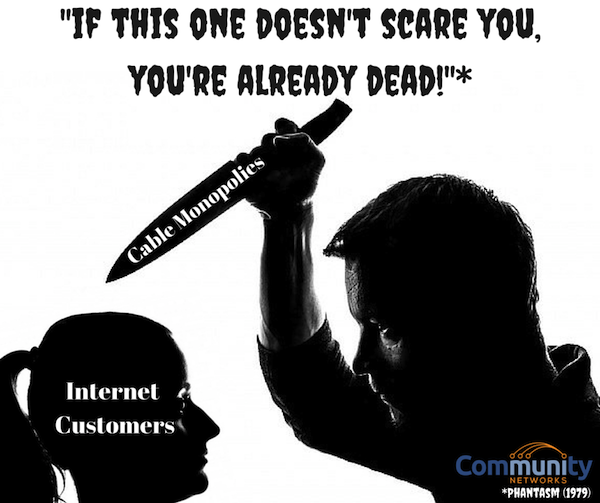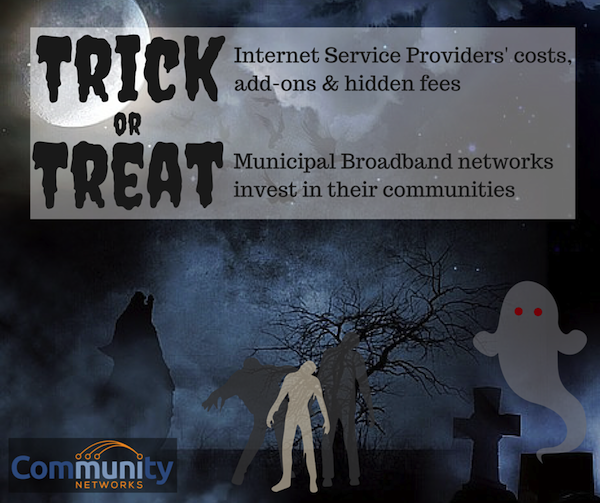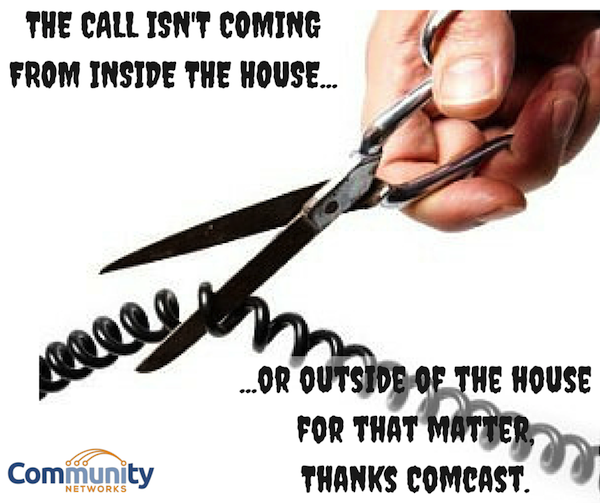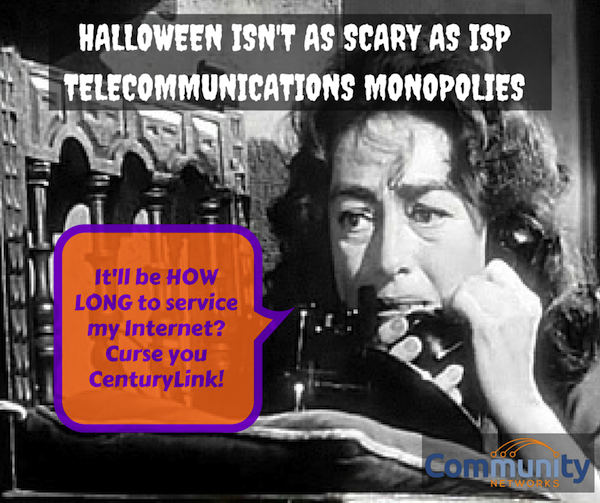
Fast, affordable Internet access for all.

The Port of Lewiston’s dark fiber network is up and running and now has connected a commercial customer, reports 4-Traders, but achieving the maximum reach has hit some resistance.
Warehousing and distribution company Inland 465, is operating a 150,000 square-foot warehouse and obtaining Internet access from First Step Internet, which leases dark fiber from the Port of Lewiston’s network. Community leaders hope this is the first of many commercial customers.
Last summer the community announced that they intended to deploy an open access dark fiber network to spur economic development opportunities. The network plan called for a connection to nearby Port of Whitman’s fiber network, which has operated for more than a decade.
Bumps On Bridges
According to 4-Traders, the Port of Lewiston is encountering issues deploying over the optimal route for expanding to serve more commercial clients. The community is near the Clearwater and Snake Rivers and must cross bridges en route to connect with nearby networks in the ports of Whitman County and Clarkston. Both communities have their own fiber networks and would like to connect to Lewiston’s new infrastructure. The collaborations would allow a larger loop and better redundancy for all three networks.
The Port of Whitman has an agreement with Cable One to use the provider's hangers on the bridge across the Clearwater River. In exchange, Cable One is allowed to access certain Port of Whitman County conduit on a different bridge. The state of Idaho issued the permit to Cable One to allow them to install the hangers and now the Port of Whitman County is applying to the state to have those same permits issued in its name. Once the Port of Whitman County has the permits, the Port of Lewiston will be able to use the hangers to connect to the Port of Whitman County network.
CenturyLink's Conduit...Or Is It?


When we launched this podcast in 2012, we kicked it off with an interview from Minnesota's farm country, Sibley County. We were excited at their passion for making sure every farm was connected with high quality Internet access. After the project took a turn and became a brand new cooperative, we interviewed them again in 2014 for episode 99, but they hadn't finished financing. They broke ground 2015 and today we discuss the model and the new Institute for Local Self-Reliance (ILSR) case study that details how they built it. City of Winthrop Economic Development Authority Director Mark Erickson and Renville-area farmer Jake Rieke are both on the board of RS Fiber Cooperative and they join us to explain how their model works.
We at ILSR believe this model could work in much of rural America, in any community that can summon a fraction of the passion of the citizens from Sibley and Renville counties. Having watched this project for all the years it was being developed, I cannot express how impressed I am with their dedication. And because they own it, I'm thrilled to know that no one can take it away from them.
This show is 35 minutes long and can be played on this page or via Apple Podcasts or the tool of your choice using this feed.
Transcript below.
We want your feedback and suggestions for the show-please e-mail us or leave a comment below.
Listen to other episodes here or view all episodes in our index. See other podcasts from the Institute for Local Self-Reliance here.
Thanks to Kathleen Martin for the music, licensed using Creative Commons. The song is "Player vs. Player."

In Minneapolis, a small and privately owned ISP has been steadily building fiber across the city and developing a stunning reputation for great customer service, low and predictable pricing, and generally being a great company to do business with. Co-founder Travis Carter of US Internet joins us for episode 194 of the Community Broadband Bits podcast.
We discuss their approach to building networks, especially their philosophy around customer service and just how poorly some of US Internet's competitors treat their customers. As a small firm that is carving out its own path in a world of giants, its experiences are important lessons and points of consideration for community networks. We also discuss how US Internet interacts with local governments. Though the company has high praise for Minneapolis, it discusses where some of the challenges have been in navigating local government zoning and permitting.
Travis also offers some advice based on how smart investments and a well-organized approach to leasing fiber have helped US Internet to begin expanding in suburb Saint Louis Park. USI coverage map is available here. For more information on USI's pricing, see their website for Fiber-to-the-Home and telephone service. We plan to have Travis back on in the future again, so if you have questions you would like us to ask, please tell us!
This show is 30 minutes long and can be played on this page or via Apple Podcasts or the tool of your choice using this feed.
Transcript below.
We want your feedback and suggestions for the show-please e-mail us or leave a comment below.
Listen to other episodes here or view all episodes in our index. See other podcasts from the Institute for Local Self-Reliance here.
Thanks to Kathleen Martin for the music, licensed using Creative Commons. The song is "Player vs. Player."
For seniors, low-income residents, and the disabled in Saint Paul, Minnesota, a Comcast discount within the city's franchise agreement is not all it was cracked up to be. The Pioneer Press recently reported that, as eligible subscribers seek the ten percent discount guaranteed by the agreement, they are finding the devil is in the details - or lack of them.
This is a warning to those who attempt to negotiate with Comcast for better service. Comcast may make deals that it knows are unenforceable.
"No Discount For You!"
For years, Comcast held the only franchise agreement with the city of St. Paul. In 2015, the city entered into a new agreement with the cable provider and, as in the past, the provider agreed to offer discounts for low-income and senior subscribers. Such concessions are common because a franchise agreement gives a provider easy access to a pool of subscribers.
It seems like a fair deal, but where there is a way to squirm out of a commitment, Comcast will wriggle its way out.
Comcast is refusing to provide the discount when subscribers bundle services, which are typically offered at reduced prices. Because the contract is silent on the issue of combining discounts, the city of approximately 298,000 has decided it will not challenge Comcast's interpretation:
The company notes that the ten percent senior discount applies only to the cable portion of a customer's bill. Comcast has maintained that it is under no legal obligation to combine discounts or promotions, and that bundled services provide a steeper discount anyway.
Subscribers who want to take advantage of the discounts will have to prove their senior status and/or their low-income status. In order to do so, Comcast representatives have been requesting a copy of a driver's license or state issued i.d.
CenturyLink Picks Up the Baton
In May, Chris introduced you to Sean Moody from Santa Fe's Economic Development Division, to explain how the community was investing in a new fiber link to better serve the local business community. With a little competition, Santa Fe officials expect more choice, better connectivity, and improved services.
CenturyLink controls the community's only connection to the Internet and the line bringing access to the web into the downtown district. Santa Fe's $1 million investment creates another path to encourage other providers to compete. Residents in Santa Fe pay approximately $50 per month for average speeds of 5 Megabits per second (Mbps) while nearby Albuquerque pays the same for 10 Mbps.
The situation may soon change.
On Monday, December 14th, the community will celebrate the investment as they "Flip the Switch and Connect Santa Fe to the Future." The event will take place at the Santa Fe City Offices and will begin at 9 a.m. Mayor Javier M. Gonzales will flip the switch at 10 a.m. to activate Santa Fe’s very first gigabit-speed Internet connection.
From the announcement:
Mayor Gonzales and the City’s Economic Development Division invite you to celebrate activating the first gigabit district in Santa Fe through Santa Fe Fiber, the City’s innovative broadband infrastructure project.
...
On Monday, December 14th from 9 until 11 AM Mayor Gonzales will be joined by special industry guests to flip the switch and experience first-hand the power and potential of gigabit-speed Internet delivered over the City’s newly completed fiber optic backbone. The community is invited to bring devices and try out the new speed!
This time of year, goblins and ghouls are in plentiful supply. There is, however, a much scarier prospect than kids in rubber masks and bad Halloween candy: the reality of our monopolistic internet service providers. Enjoy the following images designed for Halloween and feel free to distribute widely.




Happy Halloween!

View a larger version of this graphic here [pdf]. Stay up to date on community networks with our newsletter!

When Steamboat Springs resolved to improve Internet access for key community anchor institutions and businesses, they decided to make an economical investment in a carrier neutral facility to allow multiple ISPs to invest and compete with each other. In episode 163 of the Community Broadband Bits Podcast, Tim Miles explains what that means and how they did it. Tim is the Technology Director at Steamboat Springs and South Routt School Districts in Colorado.
He tells us about the poor connectivity the community had from CenturyLink and how they opened a bottleneck to encourage more investment. In part because of how Colorado limits local authority to build networks, they formed the Northwest Colorado Broadband Cooperative with the local Chamber of Commerce. They are already seeing benefits in the form of lower prices for anchor institutions and reduced outages - Tim describes just how painful those outages had been when there was no local Internet choice.
This show is 20 minutes long and can be played on this page or via Apple Podcasts or the tool of your choice using this feed.
Transcript below.
We want your feedback and suggestions for the show-please e-mail us or leave a comment below.
Listen to other episodes here or view all episodes in our index. See other podcasts from the Institute for Local Self-Reliance here.
Thanks to bkfm-b-side for the music, licensed using Creative Commons. The song is "Raise Your Hands."
Two more communities in Ohio and Colorado are seeking information through broadband feasibility studies.
The Aspen Daily News recently reported that Pitkin County has already completed phase one of its feasibility study. This past spring the primary Internet path coming into Aspen via CenturyLink fiber was severed causing widespread outage for 19 hours. The first half of the feasibility study sought ways to introduce a redundant path.
The first option was a 100 percent fiber solution and a hybrid fiber/microwave solution was proposed as an alternative. For option A, the consultants recommended a fiber backbone along Highway 82 with fiber lines running into Redstone, Marble, and Snowmass. Microwave could serve nearby Fryingpan Valley. Option B would travel the same route but make more use of microwave.
Early cost estimates:
Estimated operating costs for option A would be more than $122,000 per year, while option B would cost just over $92,000 annually. Yearly maintenance costs for the fiber-only model were projected at just under $62,000, and the hybrid model would run more than $123,000.
A survey or residents in several communities in Pitkin County indicated most are not happy with speeds or reliability of current Internet access. Approximately half of the region does not have broadband as defined by the FCC at 25 Mbps download and 3 Mbps upload.
[One of the consultants] said that according to the survey, customer satisfaction in the area is “significantly low.” It also noted that 34 percent of responders said they run a business out of their home, and an additional 10 percent replied that they will start up an in-house business within the next three years.
Adams relayed that more than half of respondents felt that the county should build some sort of “state-of-the-art communications network.”
“It’s clear that the residents would like to see the county do something,” he said.
As of this January, the FCC defines broadband as 25 Mbps downstream and 3 Mbps upstream, but in some rural areas in the United States, people are still struggling to access DSL speeds of 768 kbps. In a few extreme cases, individuals who rely on the Internet for their jobs and livelihoods have been denied access completely.
The sad state of affairs for many Americans who subscribe to the major Internet service providers like AT&T and CenturyLink was recently chronicled in an article on Ars Technica that examined AT&T’s stunning combination of poor customer service, insufficient infrastructure, and empty promises to subscribers. It tells the unfortunately common story of the little guy being systematically overlooked by a massive corporation focused solely on short-term profit maximization.
Mark Lewis of Winterville, Georgia, and Matthew Abernathy of Smyrna, Tennessee, are two examples of AT&T subscribers who, upon moving into new homes, found that not only were they unable to access basic DSL speeds, but that they had no Internet access whatsoever. Alternatively citing a lack of DSL ports and insufficient bandwidth, AT&T failed to provide Lewis Internet access over the course of nearly two years. As for Abernathy, the corporation strung him along for 9 months without providing DSL, forcing him and his wife to rely on a much more expensive Verizon cellular network to go online.